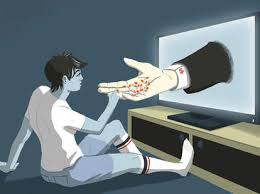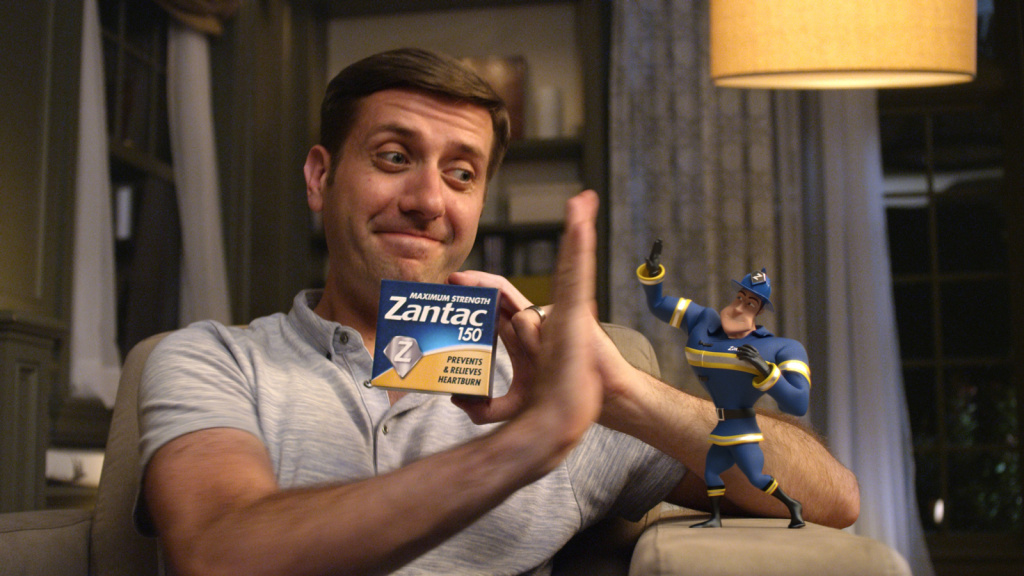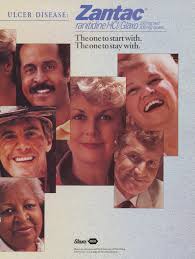Our goal at KSA is the abolition of animal experimentation. It must end not only because it is horrifically cruel, but because it is also scientific fraud. For that reason, the pharmaceutical/pesticide industry has been in our crosshairs for decades. As they vivisect animals by the millions every year, vivisectors declare they do it for the sake of finding “cures” to disease and because testing their poisons on animals keeps the public safe – all lies, of course, since animal experimentation cannot be extrapolated to humans because of differences in metabolism, physiology, genetics, biochemistry, diet, and environment. Check out https://kindnessandscience.org/we-are-not-the-same/
Now that there are tens of thousands of lawsuits against Zantac in various stages of litigation, the defense their lawyers have come up with proves without a doubt that drug companies know that animal testing is useless. But before we talk about Zantac, let’s see how we came to be a nation overwhelmed with drugs and drug commercials, including those for Zantac.

HOW DID DRUG COMMERCIALS TAKE OVER TELEVISION?
After a few road bumps on the highway to taking over television revenue, pharma was given permission by the FDA in 1985 to air drug ads. But if they made specific claims regarding the success of their drugs, they had to disclose side effects. So, one drug company launched a big campaign for Claritin, never saying exactly what it was for, and others followed suit. Because ads not making specific claims seemed ineffectual to pharma, the pharma-bought-and-paid-for FDA decided in 1997 to allow drug companies to make specific medical claims about what the drug can do at the same time referring people to their doctors and to the drug’s website to find out more about the many side effects of the drugs instead of listing all of them in the commercials. This worked well for pharma. Drug revenue grew from $360M in 1995 to $1.1B in 2023.

After the Vioxx debacle where Dorothy Hamel appeared in TV commercials pushing a drug that radically increased incidents of heart attacks and strokes, the public reacted horrified. Vioxx was pulled off the shelves as lawsuits ensued, Ted Kennedy and others in Congress tried to ban TV drug ads for two years and pushed for new restrictions. But their efforts were in vain – the massive amount of drug commercials on TV was an overflowing river that could not be stopped.
THE INSIDIOUS RESULTS OF TV DRUG ADS
There are many groups appalled by and opposed to the selling of drugs on TV and we appreciate them all. But there is one fact they overlook – one fact that we focus on time and time again and that is this: Because of the huge amount of revenue drug companies bring to every channel on TV, the pharmaceutical industry gets to control the message put out by news shows and talking heads. That is why drug companies are allowed to push their drugs, vaccines, and self-serving agendas like phony viruses and pandemics unimpeded. No talking head dares speak the truth for fear of being fired and losing the company millions of dollars in revenue.
Drug commercials have also caused a tragic change in the perception people have of themselves and their bodies. Before the Rockefeller drug empire took over our lives and before the overwhelming number of drug commercials the public is forced to view, we thought of ourselves as healthy people who occasionally became sick and had to stay home from work a couple of days or go to a doctor or surgeon to get better. Now it is imbued in us that we are a nation of sick people – that there are unseen enemies everywhere in the forms of named or unnamed viruses inside or outside our bodies, that there are physical and psychological illnesses we never knew existed until we found out from drug commercials that crying too much or laughing too much are diseases that need a drug. The bodies of newborn babies must have vaccines injected into their pure, pristine bodies because evidently God doesn’t know how to make babies anymore and must take a backseat to pharmaceutical companies and their plethora of toxic chemicals.
The billions of dollars pharma has spent on drug commercials are paying off bigtime. The least trusted industry in the world has become the most trusted – we’re all sick with something even if we feel perfectly healthy. We need their drugs and vaccines to keep the enemies at bay. God never knew what the heck he was doing when he created us in his image. The gods of pharma know best.
ZANTAC
In 1983 Zantac, brand name for ranitidine, was introduced to consumers by Sanofi as an over-the-counter drug to treat acid reflux, ulcers, heartburn, and other stomach problems.

Many of us remember the family friendly ads that made us believe that Zantac could solve all our stomach issues. Forget about eating foods that are healthy and don’t destroy the stomach lining – oh, no – eat whatever greasy, barbecued, stomach-burning foods you like, and then take Zantac to make the pain go away.

In 2019 the Food and Drug Administration issued a warning about Zantac:
“Research studies have found evidence that a chemical in Zantac called N-Nitrosodimethylamine (NDMA) might be linked to kidney cancer.”
— FDA
Zantac was voluntarily recalled, and the FDA requested that all forms of NDMA be removed from stores. Independent laboratories confirmed the presence of NDMA in Zantac and the possible harm to humans. Some of the cancers Zantac is linked to are: bladder, liver, stomach, esophageal, prostate, and breast cancer.
Even before the possibility of getting cancer from Zantac was made evident, some of the immediate side effects listed were: stomach pain, loss of appetite, dark urine, jaundice, fever, chills, cough with mucus, chest pain, shortness of breath, fast or slow heart rate, bruising, bleeding, nausea, vomiting, stomach pain, diarrhea, and constipation. But none of this convinced millions of people to choose a healthy diet over continuing to eat harmful food and taking a drug that could cause them severe harm.
ZANTAC 360
In 2022, Chattem, Inc. released a new version of Zantac – Zantac 360. Chattem has replaced ranitidine with famotidine and claims it will not cause cancer.

Some of the side effects of the “new and improved” Zantac are: anxiety, bleeding gums, blistering, peeling, blood in the urine or stools, cough, difficulty breathing, racing heartbeat, feeling sad, irritability, red spots on the skin, swelling around the eyes, and seizures, to name just a few. Whether or not Zantac 360 causes cancer we may not know for years.
ZANTACT LAWSUITS
Lawsuits against GlaxoSmithKline, Sanofi, Pfizer, and Boehringer Ingelheim are ongoing, including class action lawsuits brought by patients who have been diagnosed with bladder, liver, stomach, esophageal, and pancreatic cancer, all of them having ingested Zantac contaminated with high amounts of NDMA.
In July 2019, independent lab Valisure reported to the FDA that Zantac contained massive amounts of NDMA. The FDA says that the maximum safe level of daily NDMA is 96 ng. Valisure found that one Zantac tablet contained 2,511,469 ng of NDMA.
New studies in 2020 showed that heat causes NDMA levels to rise. The drug companies already knew this and placed a warning on packages that consumers should avoid excessive heat. Also, nitrite concentrations caused the tablet to convert more quickly into NMDA and yet some drug company defendants encouraged users to take Zantac after eating nitrate-rich food.
Even though clinical studies show that Zantac causes cancer, defense lawyers will say whatever they can to refute the evidence. One of these tactics clearly proves that drug companies know that animal testing is completely useless. When their backs are against the wall, even drug companies will tell the truth.
ANIMAL TESTING VS ANIMAL TESTING
For decades we have lamented and laughed as we watched both pro-environment groups and pesticide companies use animal testing to prove their point in court. They all do it. Groups that fight in court against pesticides and for clean air, food, and water, use animal testing to prove a point. Even John Robbins quoted animal tests in Diet for a New America, as if animal testing gave more credibility to what he was saying.
Decades ago, when malathion was being sprayed all over the L.A. area (except millionaire and billionaire enclaves) the anti-malathion groups claimed animal tests showed that malathion is harmful while American Cyanamid, the company being paid about a million dollars every time the helicopters went up, said animal tests showed malathion to be perfectly safe and must be done to kill medflies. We still have a copy of the Daily News article that reported these antithetical stances that made us shake our heads in dismay. We never understood why those pesky medflies seemed to congregate in poor areas where there were hardly any trees and avoided places with lush landscaping like Bel Air and Beverly Hills.

The debate raged on – Mythical Med Fly Infestation and Spraying vs Public Health
In 1987 when NRDC went to war with Uniroyal and their product Alar, a chemical sprayed on apples, saying it caused cancer in children, we remember both sides talking about animal tests to prove they were right. Apple growers sued the NRDC, and also CBS News for reporting on the harm caused by Alar but eventually lost their case and Uniroyal voluntarily pulled Alar off the market after apple sales plummeted by 60 per cent.
ZANTAC AND ANIMAL TESTS IN COURT
With the Zantac lawsuits in full bloom all over the country right now, let’s look at what defense lawyers are using as ammunition against plaintiffs, and at the same time making it abundantly clear what drug companies really think of animal tests.
Lawyers for the defendants submit the following from the Reference Manual on Scientific Evidence:
First, animal study results must be extrapolated to another species – human beings – and differences in absorption, metabolism, and other factors may result in interspecies variation in responses…The second difficulty with inferring human causation from animal studies is that the high doses customarily used in animal studies require consideration of the dose-response relationship and whether a threshold no-effect dose exists. —- Zantac, 2022 WL 17480906, at *162 (quoting Reference Manual, at 563)
Hallelujah! We’ve been pointing this out for decades even as drug companies claimed that animal testing was completely valid!
Defendant lawyers continued to make their points:
· “Government agencies typically utilize a lower threshold of proof than is required in tort law because agencies operate from the cautious perspective of preventing public exposure to potentially harmful substances.” (This is science? – KSA)
· “Plaintiff’s reliance on other institutions’ use of animal studies does not substitute for or explain to the Court their experts own rationale as to why they choose to rely upon the [animal] studies.”
· “Plaintiffs do not explain species extrapolation for any of the other animal species tested in the studies that they rely upon.”
· “Plaintiffs’ arguments do not address the question of how the [their] experts reliably extrapolate from the dosage of NDMA administered to animals to the dosage consumed by Plaintiffs via ranitidine.”
· Plaintiffs have failed to compare rodent livers to either the rodent or human esophagus, stomach, bladder, or pancreas to support this explanation.”
CONCLUSION
Do drug companies believe in animal testing? Absolutely not. But vivisection is a wealth-producing, billionaire-making bonanza for vivisectors, laboratories, hospitals, disease organizations, universities, breeding companies, and the entire pharmaceutical industry. They will never give it up until the public forces the NIH funding of vivisection to end.
Educating Congress and the public about the fraud of vivisection is the key. We’ll keep doing that and encourage other animal groups to do the same until the truth about vivisection reaches critical mass and the end is in sight.

We rest our case.

